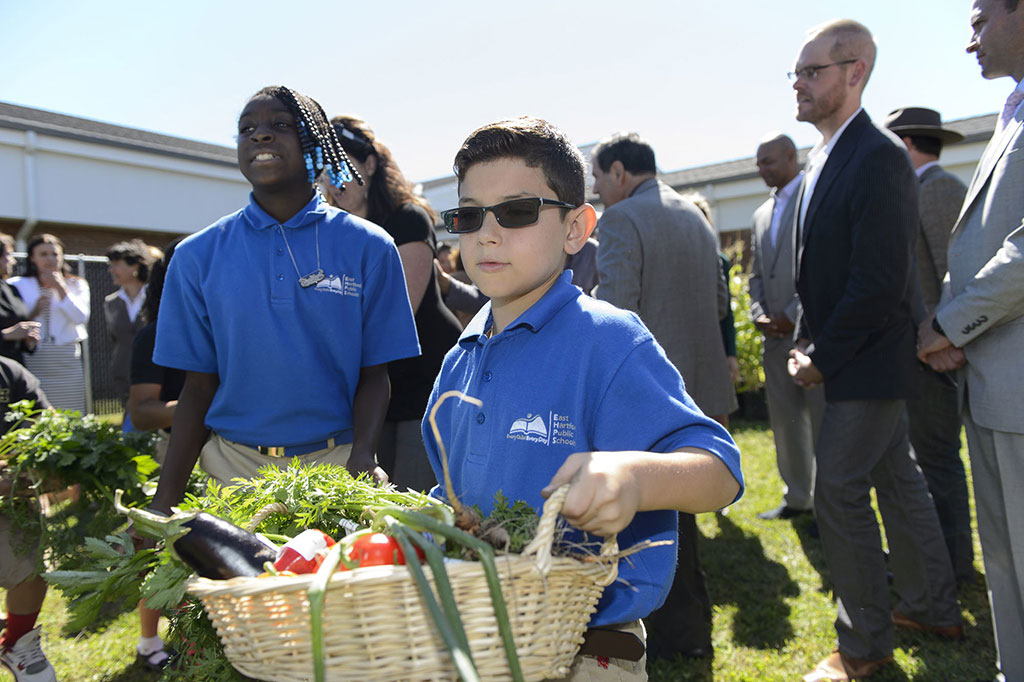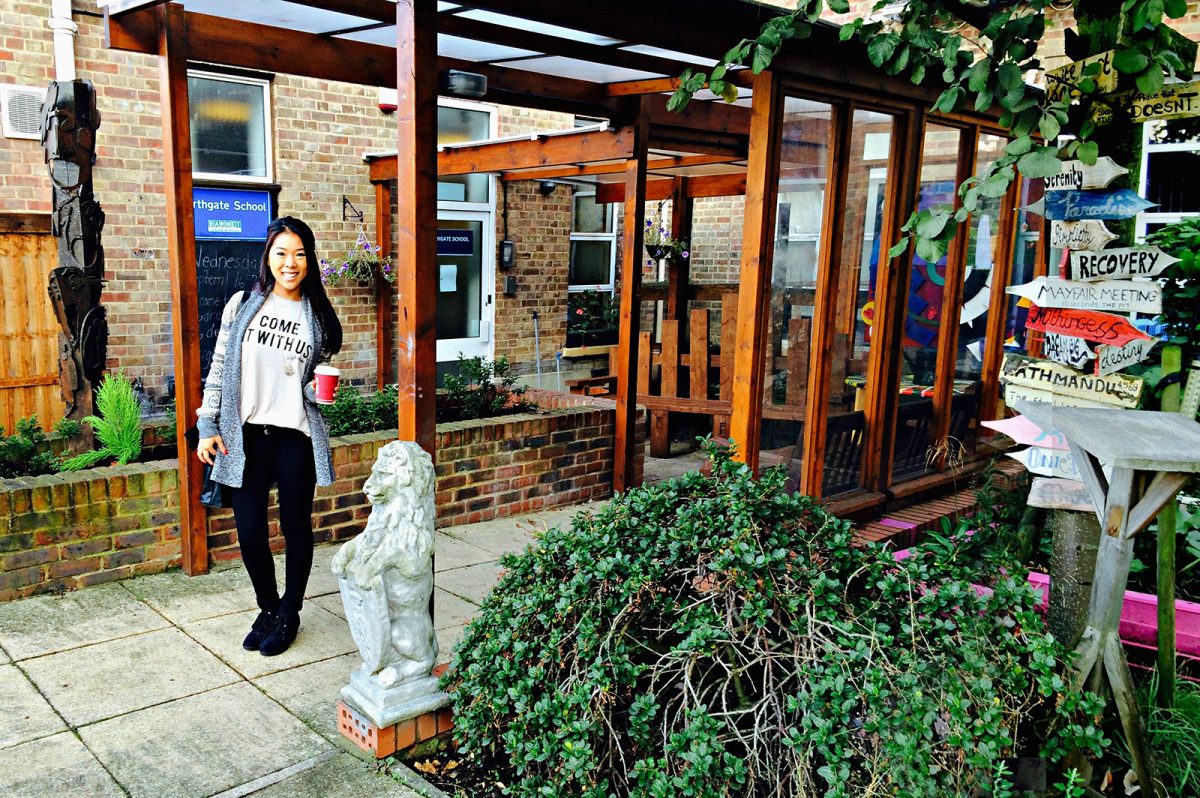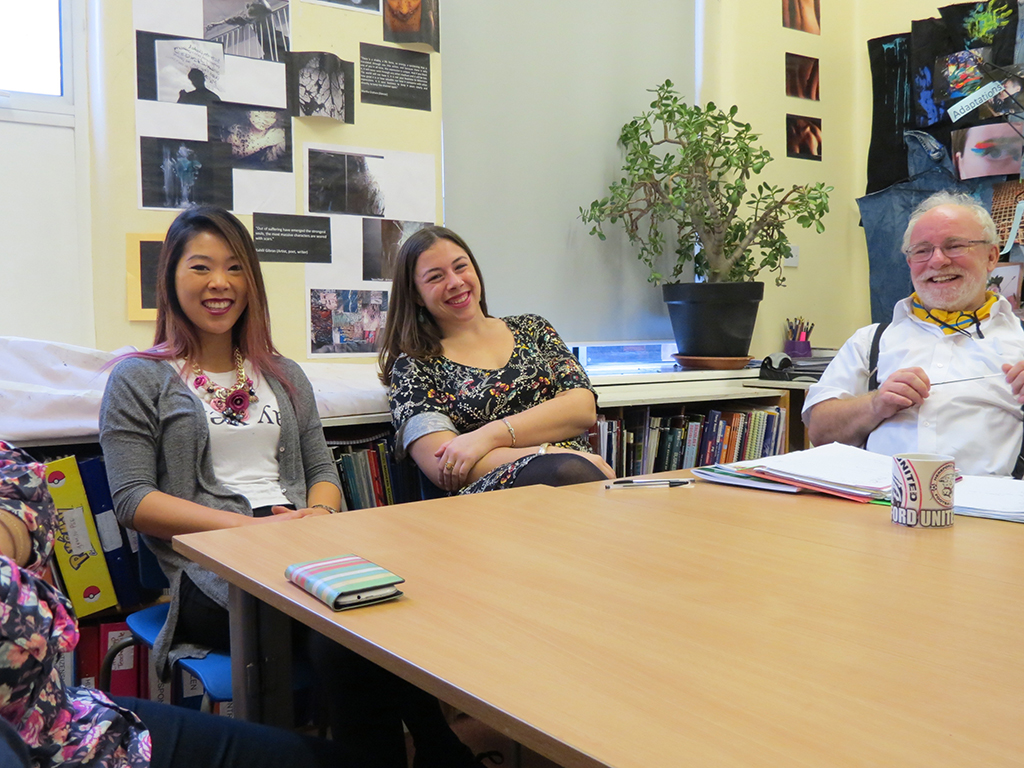The Daily Campus (Neag School’s sport management program hosted first speaker in “Beyond the Field: Social Issues in Sports” series)
North Branford Principal Studies UConn PreK-3 Leadership Program
Zip06.com (Neag School alumnus Carter Welch came back to campus for innovative Neag School leadership program)
Guilford Learning Goes Global
Zip06.com (UCAPP’s educational leadership partnership in Jordan featured)
UConn Teaching Duo Share Office at Staples
Westport News (Two TCPCG alumni head to Staples High School in Westport, Conn., as English teachers)
Food Justice: Access, Equity, & Sustainability for Healthy Students & Communities
Editor’s Note: The following excerpt comes from an article — titled “Food Justice: Access, Equity, and Sustainability for Healthy Students and Communities” — co-authored by Neag School associate clinical professor René Roselle and first-year educational leadership doctoral student Chelsea Connery ’13 (ED), ’14 MA, who is also an alum of the Neag School Integrated Bachelor’s/Master’s (IB/M) program. In this piece, Roselle and Connery examine the issue of food insecurity and its impact on student achievement, touching on an example of one Connecticut city that is working toward a solution.

The article originally appeared in the Oct.-Dec. 2016 issue of peer-reviewed journal Kappa Delta Pi Record. Access the original article in full, for free, via the Taylor & Francis website.
To sustain our democracy and promote social justice, we must focus on the serious issue of food insecurity in the United States. …
The United States Department of Agriculture defined food insecurity as “the absence of sufficient food for a healthy and active lifestyle for all household members and existing food that does not meet nutritional requirements.” The food insecure population increased sharply from 11.1 percent of households in 2007 to 14.6 percent in 2008 and has been greater than 14 percent ever since (U.S. Department of Agriculture, 2014). …
“Good nutrition is vitally important in constructing a solid foundation that impacts a child’s future physical and mental health, academic achievement, and economic productivity.” René Roselle, associate clinical professor, and Chelsea Connery ’13 (ED), ’14 MA, doctoral student
Good nutrition is vitally important in constructing a solid foundation that impacts a child’s future physical and mental health, academic achievement, and economic productivity. Children, more than any other population, need access to healthy foods to fuel their developing brains and bodies and to support their performance in school. Undernourished students may be more irritable, have difficulty concentrating, have lower energy levels, and get sick more often. Failing to provide children with good nutrition puts them at risk for not being able to meet their full potential. In addition, children who experience food insecurity may be at higher risk for truancy, behavioral issues, and social difficulties. …
If the health of our democracy is directly tied to the health of our public schools … it only follows that the nutritional health of our children and their access to healthy foods should be part of the current social justice conversations.
Citation: René Roselle & Chelsea Connery (2016) Food Justice: Access, Equity, and Sustainability for Healthy Students and Communities, Kappa Delta Pi Record, 52:4, 174-177, DOI: 10.1080/00228958.2016.1223993
This original article appears in the Oct.-Dec. 2016 issue of peer-reviewed journal Kappa Delta Pi Record. Access it in full, for free, via the Taylor & Francis website.
Special Education Abroad: Teaching in U.K. Classrooms That Offer ‘Safe Space for Recovery’
Imagine a school where students, ranging in age from 13 to 19 years old, do not regularly show up for class every day. Those who do attend may abruptly walk out in the middle of a lesson. And just outside this school’s entrance is a short, paved path that leads to an on-premises, partner hospital clinic, where most of the school’s adolescent students, facing a wide range of mental health challenges, have been admitted as patients for treatment for anywhere from two weeks to a year.
Each fall, it is here — at Northgate School in North London — that several of the Neag School’s aspiring teachers arrive to intern as part of the London Study Abroad Teaching Internship Program, one of several opportunities for international study in teacher education.

Northgate is not your typical elementary or secondary school, even by U.K. standards. It is a place dedicated to working closely with its students’ caregivers and psychiatrists to offer a safe space for recovery, and to ensure a smooth transition for its students back into mainstream schools.
“What has been built here is a school that has outstanding results and gets young people to work through their mental health challenge. No matter how unwell they are, they continue learning,” says former headteacher Athy Demetriades. “It ensures that they have a safety net of support when they leave here. At the same time, you’re trying to eliminate the appalling stigma that comes along with being unwell.”
“You really need to be cognizant of what your students are going through, to get to know them. It shouldn’t just be direct instruction.” Grace Healey ’15 (ED), ’16 MA
This past academic year, two Neag School students accepted into the London Study Abroad program spent the fall semester of their master’s year teaching at Northgate: Grace Healey ’15 (ED), ’16 MA, now a special education teacher at Cooperative Educational Services and a research assistant at Johns Hopkins University’s Center for Research and Reform in Education, and Audrey Kelley ’15 (ED), ’16 MA, today a teacher at Monument Academy, a public charter school in Washington, D.C. They were two of 16 students from UConn who spent last fall semester immersed in the Neag School’s London program.
And although Healey and Kelley had each previously served in teaching capacities in locations abroad — Healey for two months in Cambodia and Kelley during a semester in South Africa — interning in Northgate’s small and specialized setting in London still proved to be an entirely new experience for them both.
‘It’s not about you’
For Healey, who had been a student-teacher and volunteer tutor in the States in addition to her two months of teaching in Cambodia, the day-to-day experience at Northgate stood in stark contrast to what she refers to as a more “rigid” school-day schedule that is typical of the Connecticut school system to which she had been accustomed.
With Northgate focused first and foremost on its students’ mental health, conventional lessons and activities do not always go as planned. When children act out in class, seem to be off-task, or are not paying attention, instructors work to redirect the lessons toward the student, says Healey, whose degree concentration at the Neag School was special education.
“It’s not about you — it’s about the kids,” says Healey, a native of Fairfield, Conn. “You really need to be cognizant of what your students are going through, to get to know them. It shouldn’t just be direct instruction.”

Fellow intern Kelley, who was pursuing a concentration in elementary education, found herself taking a step back throughout her initial few weeks at Northgate, at first observing from afar.
“I had been so used to primary [school], so used to kids immediately loving you,” she says. “That was kind of hard at first. As a teacher, you just want to get your hands in and work. If you normally work in a school, you work with kids immediately and know how to work effectively with them. But here, I didn’t know if there were triggers, if there was anything I did or said that would set a kid off or make them feel uncomfortable.”
At the same time, the subject matter of the classes also proved to be unlike what the interns had encountered in U.S. classrooms.
“They have a really different curriculum [in the U.K.] — much more comprehensive,” Kelley says, who, in addition to teaching English classes at Northgate, was able to apply her interest in social justice and human rights issues and lead an ethics and sexual health class.
For Neag School interns past and present who are part of the London program, acquiring these new perspectives at a school like Northgate is certainly by design. “One of the key features of our global program for pre-service teachers is the opportunity for them to experience cultural and professional difference,” says associate professor David Moss, director of global education for the Neag School, who has been coordinating the London program for nearly 20 years. “Such comparative global perspectives offer our interns an opportunity to step back from the notion of what is typical in schools and carefully consider if their practice is truly in the best interest of their students.”
In addition, Northgate is a school that specifically offers its student body a special level of freedom to be creative. From painting and creative writing to drumming and filmmaking, its students are encouraged to express themselves through art in all forms — what one former Northgate student called “art from the heart,” says Demetriades.
“It’s not easy being here, and it’s not easy hearing the stories that we hear. I love the professionalism of [our Neag School interns] rising above all of that, and continuing to focus on what’s important for the child.” Athy Demetriades, former Northgate School headteacher
Rising Above
Demetriades, who retired this past year after working for many years at Northgate, is quick to credit both Healey and Kelley for their professionalism, enthusiasm, and skill in the classroom — as well as the many Neag School students who have interned at Northgate in past years.
“From the very first student, we were hooked,” she says of Northgate’s longtime partnership with the Neag School and its teaching internship program. “The people [we] get are fresh, charismatic. You have additional superb teachers working alongside you; there’s no training to be done. … I think that the growth on both sides is phenomenal. We learn from each other. They bring a different system, a different inspiration.”

Before long, Kelley came to feel more comfortable with the unique challenges of teaching at Northgate. She says she realized that “if [the students] leave the classroom, it’s not an offense to you. Sometimes something is going on at home, and you need to be respectful of that, to try to understand and give them the coping skills to come back into the classroom.”
Yet the challenge of teaching abroad, in a school setting and with a curriculum different from that of schools in the States, was raised to another level when Healey faced a particularly sensitive situation in which a student confided in her about unsafe circumstances at home.
“That was very hard,” says Healey. But “I think the Neag [School] prepared me professionally and with techniques to handle the classroom and behavior — especially in special education — and the really deep issues that come along with mental health.”
“It’s not easy being here, and it’s not easy hearing the stories that we hear,” Demetriades says. “I love the professionalism of [our Neag School interns] rising above all of that, and continuing to focus on what’s important for the child.”
Getting firsthand experience at Northgate and having the opportunity to work in a setting so different from a mainstream school was, Kelley says “definitely the most beneficial for me — and being able to see different support systems that are put in place for different needs of a student. It will allow me to think about what can be applied to the schools I work at in the future [and] it taught me a lot for my own personal classroom, so I can be responsive and more understanding.”
Learn more about the Neag School’s London Study Abroad Teaching Internship Program here. Find more information here about this and other Study Abroad experiences and global initiatives at the Neag School. Or, contact Associate Professor David Moss, Director of Global Education for the Neag School, at david.moss@uconn.edu. Find additional information about the Neag School’s Integrated Bachelor’s/Master’s (IB/M) program here.
Check out the stories of other Neag School London Study Abroad Teaching Internship alumni:
The Road to Higher Education With an ‘Invisible Disability’
The Atlantic (Neag School’s Joseph Madaus was interviewed for this story)
Rocky Hill Principal Spends the Day on the Roof
Hartford Courant (Rocky Hill principal and Neag School alumnus, Scott Nozik, spent the day on his school’s roof after the town’s students read 6,000 books)
Narragansett Names Dr. Peter Cummings New Superintendent
The Independent (Peter Cummings, a Neag alumnus, was named superintendent of Narragansett Public Schools)
Zeroing in on Zero Tolerance
WNPR (Neag School’s George Sugai was a guest panelist on zero tolerance policies in Connecticut)
